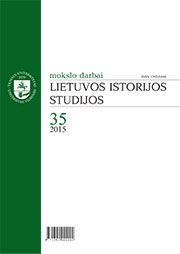PRIVATAUS DOKUMENTO PATVIRTINIMO PRIEMONĖS LIETUVOS DIDŽIOJOJE KUNIGAIKŠTYSTĖJE XIV AMŽIAUS PABAIGOJE–XV AMŽIUJE
VERIFICATION MEASURES OF A PRIVATE DOCUMENT IN THE GRAND DUCHY OF LITHUANIA IN THE END OF THE 14TH –15TH C.
Author(s): Mindaugas KlovasSubject(s): Public Administration, 13th to 14th Centuries, 15th Century
Published by: Vilniaus Universiteto Leidykla
Keywords: diplomatics; charter; private document; seal; signiture; notary
Summary/Abstract: In the end of the 14th–15th c., 250 full private documents written in the Grand Duchy of Lithuania were known. In the end of the 14th century, early private documents were approved by the issuer seal, list of witnesses and the scribe direction. However, eventually it was not consistently observed. The research shows obvious differences which confirm not only different types of documents, but also different writing traditions (Latin and Ruthenian). For example, a bigger part of the Latin private documents (donations, sales, testimonies, etc.) were approved by the seal of one issuer, but the Ruthenian practice of sales documents approval was ambivalent. Since their emergence (from the middle of the 15th c.), one part of documents were approved only by the issuer seal and the other part by the issuers’ and witnesses’seals together. Since the 8th decade of the 15th century, the biggest part of Ruthenian sales was approved by issuer and witnesses seals. The Latin sales were stamped only by the issuer, but at the end of the 15th century there several sales which were approved by the seals of the listed witnesses (obviously it was the influence of the Ruthenian practice). Also, the article analyzes the use of the list of witnesses, the recording of clericals and secular officials, the practice of notaries, scribes’ naming, and others.
Journal: Lietuvos istorijos studijos
- Issue Year: 2015
- Issue No: 35
- Page Range: 24-39
- Page Count: 16
- Language: Lithuanian

